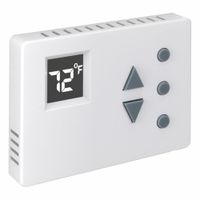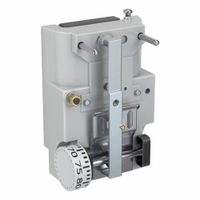Call +(254) 703 030 000 / 751 483 999 / 721 704 777
- Home
- Hvac And Refrigeration
- Hvac Controls And Thermostats
- Thermostats
- Pneumatic Thermostats Retrofit Kits
.....Read More
Frequently Asked Questions
What is a pneumatic thermostat and how does it work?
A pneumatic thermostat is a device used to control the temperature within a building by regulating the flow of air in heating, ventilation, and air conditioning (HVAC) systems. It operates using compressed air as the control medium, rather than electricity, which is common in older or large commercial buildings.
The core components of a pneumatic thermostat include a temperature sensor, a bimetallic strip, a nozzle, a flapper, and a relay system. The bimetallic strip, made of two metals with different expansion rates, bends in response to temperature changes. This bending action moves a flapper closer to or further from a nozzle, which is connected to a compressed air supply.
When the room temperature deviates from the setpoint, the bimetallic strip adjusts the position of the flapper. If the temperature rises, the strip bends, moving the flapper closer to the nozzle, increasing the back pressure in the system. This increased pressure is transmitted through pneumatic tubing to a control valve or actuator, which adjusts the flow of air to the heating or cooling system, thereby reducing the temperature.
Conversely, if the temperature falls, the strip moves the flapper away from the nozzle, decreasing the back pressure. This reduced pressure signals the control valve to increase airflow, raising the temperature.
Pneumatic thermostats are valued for their simplicity, reliability, and ability to operate in environments where electrical devices might pose a risk. However, they require regular maintenance to ensure the air supply is clean and free of leaks, as any disruption can affect their accuracy and efficiency.
How do you retrofit a pneumatic thermostat system?
To retrofit a pneumatic thermostat system, follow these steps:
1. **Assessment**: Evaluate the existing pneumatic system, including thermostats, actuators, and control valves. Identify components that need replacement or upgrading.
2. **Design**: Develop a retrofit plan that integrates digital controls with the existing pneumatic infrastructure. Choose a Direct Digital Control (DDC) system compatible with pneumatic components.
3. **Component Selection**: Select electronic thermostats and transducers that convert digital signals to pneumatic outputs. Ensure compatibility with existing actuators and valves.
4. **Installation**:
- **Thermostats**: Replace pneumatic thermostats with electronic ones. Ensure proper wiring and connectivity to the DDC system.
- **Transducers**: Install electro-pneumatic transducers to interface between digital controls and pneumatic devices.
- **Wiring**: Run necessary wiring for power and communication between new components and the central control unit.
5. **Integration**: Connect the DDC system to the building's network for centralized monitoring and control. Ensure seamless communication between digital and pneumatic components.
6. **Calibration**: Calibrate the new system to ensure accurate temperature control and response. Adjust settings on transducers and thermostats for optimal performance.
7. **Testing**: Conduct thorough testing of the retrofitted system. Check for proper operation of thermostats, transducers, and actuators. Verify that the system responds correctly to control inputs.
8. **Training**: Train maintenance staff on the new system's operation and troubleshooting. Provide documentation and support resources.
9. **Monitoring**: Implement a monitoring strategy to track system performance and identify issues early. Use the DDC system's capabilities for data logging and analysis.
10. **Maintenance**: Establish a regular maintenance schedule to ensure long-term reliability and efficiency of the retrofitted system.
This process enhances control precision, energy efficiency, and system reliability.
What are the benefits of using pneumatic thermostats in older buildings?
Pneumatic thermostats offer several benefits for older buildings:
1. **Compatibility**: Older buildings often have existing pneumatic HVAC systems. Pneumatic thermostats are directly compatible with these systems, eliminating the need for costly upgrades or replacements.
2. **Cost-Effectiveness**: Installing pneumatic thermostats is generally less expensive than converting to digital or electronic systems. They use existing infrastructure, reducing installation and maintenance costs.
3. **Simplicity and Reliability**: Pneumatic systems are known for their simplicity and durability. They have fewer electronic components, which means they are less prone to failure and can be more reliable over time.
4. **Ease of Maintenance**: Maintenance of pneumatic systems is straightforward, often requiring basic mechanical skills. This can be advantageous in older buildings where access to advanced technical support may be limited.
5. **Energy Efficiency**: Properly calibrated pneumatic thermostats can improve energy efficiency by maintaining consistent temperature control, reducing energy waste associated with overcooling or overheating.
6. **No Electrical Interference**: Pneumatic systems do not rely on electrical power, making them immune to electrical interference and power outages, which can be beneficial in buildings with outdated electrical systems.
7. **Preservation of Historical Integrity**: For historically significant buildings, pneumatic thermostats allow for climate control without altering the building's original design or aesthetics, preserving its historical value.
8. **Environmental Benefits**: Pneumatic systems use compressed air, which is environmentally friendly compared to some electronic systems that may rely on refrigerants with high global warming potential.
9. **Scalability**: Pneumatic systems can be easily expanded or modified to accommodate changes in building use or layout without significant infrastructure changes.
These benefits make pneumatic thermostats a practical choice for maintaining comfort and efficiency in older buildings.
How do direct-digital-control (DDC) pneumatic thermostats differ from traditional ones?
Direct-digital-control (DDC) pneumatic thermostats differ from traditional pneumatic thermostats primarily in their integration with digital systems and enhanced control capabilities.
Traditional pneumatic thermostats operate using compressed air to control HVAC systems. They rely on mechanical components and air pressure changes to adjust temperature settings. These systems are generally standalone, with limited programmability and no connectivity to broader building management systems.
In contrast, DDC pneumatic thermostats incorporate digital technology to enhance functionality. They convert analog signals from pneumatic systems into digital data, allowing for more precise control and monitoring. This integration enables DDC systems to connect with centralized building management systems (BMS), facilitating remote monitoring, data logging, and advanced analytics.
DDC systems offer programmability, allowing for complex scheduling and setpoint adjustments based on occupancy, time of day, or other parameters. They can also integrate with other building systems, such as lighting and security, to optimize energy efficiency and occupant comfort.
Furthermore, DDC thermostats provide real-time feedback and diagnostics, enabling quick identification and resolution of issues. This capability reduces maintenance costs and improves system reliability.
Overall, DDC pneumatic thermostats offer enhanced precision, connectivity, and control compared to traditional pneumatic systems, leading to improved energy efficiency and operational effectiveness in building management.
What are common issues with pneumatic thermostats and how can they be fixed?
Common issues with pneumatic thermostats include:
1. **Calibration Drift**: Over time, thermostats may lose calibration, leading to inaccurate temperature control. Fix this by recalibrating the thermostat according to the manufacturer's instructions, often involving adjusting the setpoint and feedback mechanisms.
2. **Air Leaks**: Leaks in the pneumatic lines can cause pressure loss, affecting thermostat performance. Inspect and repair or replace damaged tubing, fittings, or connections to ensure airtight integrity.
3. **Dirt and Debris**: Accumulation of dirt can clog the thermostat's internal components, affecting its operation. Regularly clean the thermostat and associated components using compressed air or a soft brush to remove debris.
4. **Diaphragm Failure**: The diaphragm inside the thermostat can wear out or rupture, leading to malfunction. Replace the diaphragm with a new one, ensuring compatibility with the existing system.
5. **Improper Setpoint**: Incorrect setpoints can lead to discomfort and inefficiency. Verify and adjust the setpoint to match the desired temperature range for the space.
6. **Temperature Sensor Issues**: Faulty sensors can provide incorrect readings. Test the sensor for accuracy and replace it if necessary.
7. **Control Valve Problems**: Malfunctioning control valves can disrupt airflow. Inspect and service the control valves, cleaning or replacing them as needed.
8. **Pressure Imbalance**: Inconsistent air pressure can affect thermostat operation. Check the air supply system for proper pressure levels and adjust the pressure regulator if required.
9. **Aging Components**: Older thermostats may have worn-out parts. Consider upgrading to newer models with improved reliability and features.
Regular maintenance and timely repairs can mitigate these issues, ensuring efficient and reliable operation of pneumatic thermostats.
How do pneumatic thermostat retrofit kits improve system efficiency?
Pneumatic thermostat retrofit kits improve system efficiency by upgrading outdated pneumatic control systems to more modern, efficient ones. These kits typically include digital or electronic components that replace or augment the existing pneumatic thermostats. Here’s how they enhance efficiency:
1. **Precision Control**: Digital components provide more accurate temperature control compared to traditional pneumatic systems, reducing temperature fluctuations and maintaining optimal comfort levels with less energy use.
2. **Energy Savings**: By improving temperature accuracy, these kits reduce the energy consumption of HVAC systems. They prevent overcooling or overheating, which are common in less precise pneumatic systems.
3. **Remote Monitoring and Control**: Many retrofit kits offer remote monitoring capabilities, allowing facility managers to adjust settings and diagnose issues without being physically present. This leads to quicker response times and reduced downtime.
4. **Integration with Building Management Systems (BMS)**: Retrofit kits often enable integration with BMS, allowing for centralized control and monitoring of HVAC systems. This integration facilitates better energy management and system optimization.
5. **Reduced Maintenance Costs**: Digital components are generally more reliable and require less maintenance than pneumatic systems, which are prone to leaks and mechanical failures. This reduces maintenance costs and extends the lifespan of the HVAC system.
6. **Data Collection and Analysis**: Modern retrofit kits can collect data on system performance, which can be analyzed to identify inefficiencies and areas for improvement, leading to further energy savings.
7. **Environmental Impact**: By reducing energy consumption, these kits contribute to lower greenhouse gas emissions, supporting sustainability goals.
Overall, pneumatic thermostat retrofit kits enhance system efficiency by providing precise control, reducing energy consumption, enabling remote management, and integrating with advanced building management systems.
What accessories are available for pneumatic thermostats and what do they do?
Accessories for pneumatic thermostats include:
1. **Cover Plates**: Protect the thermostat from dust and damage while providing an aesthetic finish.
2. **Thermostat Guards**: Prevent unauthorized access and tampering, often used in public or commercial spaces.
3. **Remote Setpoint Adjusters**: Allow users to adjust the temperature setpoint from a different location, enhancing convenience and flexibility.
4. **Temperature Sensors**: Provide accurate temperature readings to the thermostat, ensuring precise control of the HVAC system.
5. **Humidistats**: Measure and control humidity levels in conjunction with the thermostat, optimizing comfort and air quality.
6. **Pressure Gauges**: Monitor the air pressure in the pneumatic system, ensuring it operates within the desired range for efficient performance.
7. **Air Filters**: Clean the air supply to the thermostat, preventing dust and debris from affecting its operation.
8. **Mounting Brackets**: Facilitate easy and secure installation of the thermostat on walls or panels.
9. **Calibration Tools**: Used to adjust and fine-tune the thermostat for accurate temperature control.
10. **Pneumatic Relays**: Amplify or switch pneumatic signals, allowing the thermostat to control multiple devices or systems.
11. **Tubing and Fittings**: Connect the thermostat to the pneumatic control system, ensuring proper air flow and signal transmission.
12. **Dampers and Actuators**: Work with the thermostat to regulate airflow in ducts, maintaining desired temperature and ventilation levels.
These accessories enhance the functionality, security, and efficiency of pneumatic thermostats, ensuring optimal performance in various settings.



